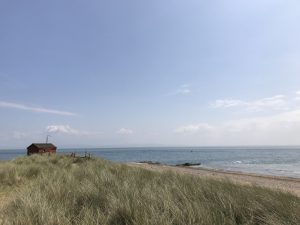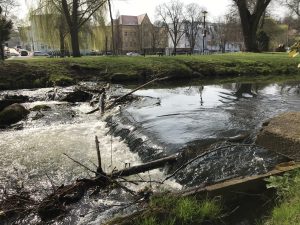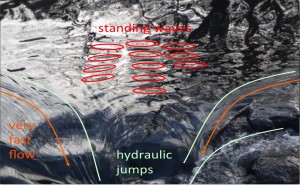
Tag: hydraulic jump


Watching the tides cause an hydraulic jump in the Irish Sea!
Looking at the picture above, taken in the South Walney Island Nature Reserve on our walk yesterday, what is the first thing you notice? For me, it is not the…

A tiny waterfall, super- and subcritical flows, submerged hydraulic jump, standing waves. What more could anyone want?
Last stop on my work trip that — apart from doing important work, obviously — brought me to Berlin for some wave watching and to Brodowin to look at beaver…

Asking students to take pictures to help them connect theory to the reality of their everyday lives
— This post was written for “Teaching in the Academy” in Israel, where it was published in Hebrew! Link here. — Many times students fail to see the real-life relevance of…

Who is faster, the currents or the waves? The Froude number
A very convenient way to describe a flow system is by looking at its Froude number. The Froude number gives the ratio between the speed a fluid is moving at,…

Standing waves in a current
The other day I found the perfect standing waves on a current: This egg-carton-like pattern really stays pretty constant over time and I think the changes in the wave pattern…

Observing hydrodynamic phenomena on a creek
Looking at a creek on a Sunday stroll, and seeing lots and lots of concepts from hydrodynamics class. For example below, you see waves radiating from each of the ducks. And…

Using twitter as a tool to let students discover that the topics of their courses are EVERYWHERE
This is a method that I have been excited about ever since learning about #birdclass in the “Evidence-based undergraduate STEM teaching” MOOC last year: Help students discover that the content of…

Submerged hydraulic jump – observing hydrodynamic phenomena in real life
Hydraulic jumps, especially submerged ones, are a very theoretical concept for many students, one that occurs in a lab experiment if they are lucky, but more likely only seems to…

Hydraulic jumps when filling a tank
The most impressive hydraulic jump might be in the Denmark Strait, but there are others around, too! [deutscher Text unten] When filling the big wave tank with a hose, we…

Standing waves
Standing waves caused by rocks in a current. I am incredibly fascinated by standing waves. The standing waves are caused by rocks sitting in a current. From the pictures below…

Wind waves meet current
Wind waves on one side of the current – no waves on the other. Recently in Bergen, I was walking to meet up with a friend at the kayak club,…

Hydraulic jump II
More movies of my kitchen sink. I am really fascinated by the hydraulic jumps in my kitchen sink. I can’t believe I haven’t used this before when I was teaching!…

Hydraulic jumps
Water changing its velocity from above to below the critical velocity. Recently in beautiful Wetzlar: The river Lahn flows through the city below the medieval cathedral at sunset. And I’m…